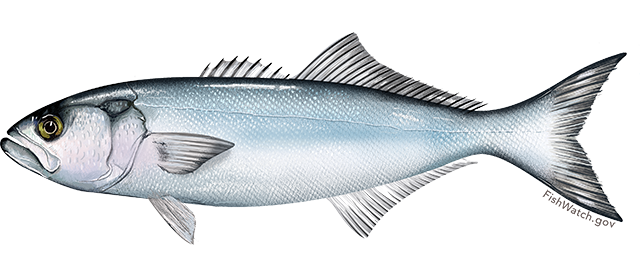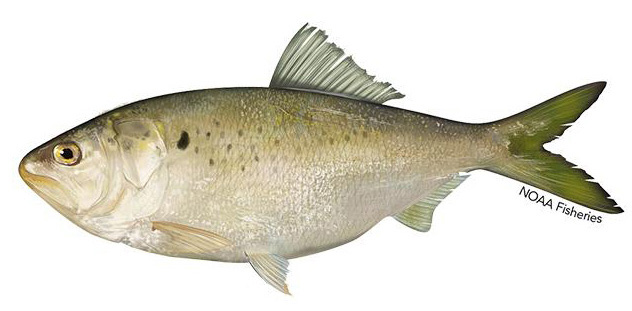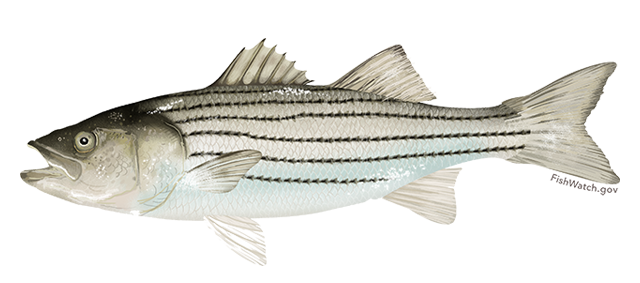Part 2: Participants in Federal Fisheries Management
The Magnuson-Stevens Act
The Magnuson-Stevens Fishery Conservation and Management Act, known as the Magnuson-Stevens Act or MSA, was originally passed in 1976 and is the primary federal fisheries management statute for the United States. The Magnuson-Stevens Act authorized the federal government to regulate fishing from three miles offshore (nine miles off Florida and Texas) out to 200 miles. This area is referred to as federal waters or the Exclusive Economic Zone (EEZ). (The waters closer to shore are state waters.)
Congress delegated the authority for the MSA to the Department of Commerce National Marine Fisheries Service (NMFS), primarily, with the U.S. Coast Guard sharing some enforcement duties. NMFS is an agency of the National Oceanic and Atmospheric Administration (NOAA), also within the Department of Commerce. For this reason, sometimes NMFS is referred to as NOAA Fisheries.
The Magnuson-Stevens Act was amended in 1996 by the Sustainable Fisheries Act (SFA) (Pub. L. 104-297). The SFA’s most notable changes to fisheries management related to bycatch and the conservation of fish habitat. In addition, the SFA added three National Standards for fishery conservation.
In 2007 Congress again reauthorized and amended the MSA with the MSA Reauthorization Act of 2006 (Pub. L. 109-479). (The date disparity is due to its being introduced in 2006, but signed into law in 2007.) The 2007 Amendments to the MSA required Fishery Management Plans (FMPs) to include Annual Catch Limits (ACLs) based on scientific standards to ensure that overfishing did not occur. In a House Report, Congress described the increased role of science under the 2007 Amendments to the MSA as the Act's “most important” managerial tool. As part of ensuring ACLs were met, Congress required that FMPs include accountability measures (AMs) that could alter fishing practices in order to protect against overfishing without a Council having to amend the FMP under formal rulemaking. 16 U.S.C. § 1853(a)(15).
Reauthorization
A periodic review of an Act by Congress is sometimes termed a “Reauthorization,” such as appears in the name Magnuson-Stevens Fishery Conservation and Management Reauthorization Act of 2006. However, the Magnuson-Stevens Act would not disappear if it were not “reauthorized” by Congress. Congress would have to enact legislation that clearly revoked the statute to eliminate the law’s legal effect.
Regional Fishery Management Councils
In order to manage and conserve fish stocks, the Magnuson-Stevens Act created eight regional Fishery Management Councils that are overseen by NOAA. Each Council develops FMPs for the stocks in their geographical region specifying how a fishery will be managed. These plans regulate, among other things, gear types, seasons, quotas, and licensing. Nationwide, 479 stocks or stock complexes are managed under the terms set in 46 FMPs. In addition to developing FMPs, Councils also direct research to advance the understanding of fish management.
| Eight Regional Fishery Management Councils | |
| The number of voting members is shown in parenthesis. | |
| New England (17) | Gulf of Mexico (17) |
| Mid-Atlantic (21) | Pacific (14) |
| South Atlantic (13) | North Pacific (11) |
| Caribbean (7) | Western Pacific (13) |
 |
|
Image Source: U.S. Regional Fishery Management Councils |
|
Where fisheries go beyond the geographical area of a single Council, the Councils can decide that one will prepare the FMP, or that they will jointly prepare the FMP with one Council acting as lead.
 Bluefish
Bluefish
Example of Interregional Fishery Cooperation
The Atlantic Bluefish FMP is issued by the Mid-Atlantic FMC, but the fishery extends from Maine to Florida. The plan establishes a Bluefish Monitoring Council with representatives from the New England FMC, Mid-Atlantic FMC, South Atlantic FMC, Atlantic Regional Fisheries Commission, and representatives from NMFS. The plan allows states to trade quotas. In 2020, Maine gave 15,000 lbs. of its commercial bluefish quota to Rhode Island, and New Jersey gave 50,000 lbs., New Hampshire gave 9,000 lbs., and Virginia gave 25,000 lbs. all to North Carolina. 85 Fed. Reg. 62613 (Oct. 5, 2020); 85 Fed. Reg. 63460 (Oct. 8, 2020); 85 Fed. Reg. 67683 (Oct. 26, 2020). This prevented Rhode Island and North Carolina from exceeding their quotas.
The Western Pacific FMC has a slightly different regulatory reach than the other seven Councils, due to geography. The region’s waters comprise half of the U.S. EEZ, surrounding Hawai’i and territories from Guam to American Samoa. Instead of FMPs, the Western Pacific employs fishery ecosystem plans to manage thousands of species.
Council Members
Each of the eight regional Councils is made up of representatives from the states in that Council’s region as well as several federal representatives. In addition, each Council has a full-time executive director and staff to assist in writing FMPs and related materials, coordinating Council meetings, committees, and advisory panels, and conducting public hearings. Council staff are useful contacts to answer questions about FMPs, committees and advisory panels, and provide the names and phone numbers of current voting and non-voting members. (Contact information for the Councils can be found at http://www.fisherycouncils.org/.)
The Magnuson-Stevens Act requires that the members of each Council reflect the expertise and interest of the states and specifies how many members each Council shall have. Council members who vote include:
- Each state’s director of marine fisheries (or equivalent as designated by the Governor);
- One person from each state who knows fishing or marine conservation, nominated by a Governor and selected by the Secretary of Commerce;
- Qualified at-large members from any of the states in the region nominated by Governors and appointed by the Secretary of Commerce;
- The Regional Director of NMFS for the area. (If two directors are within that geographical area, the Secretary of Commerce designates which director is the voting member);
- In the case of the Pacific Council, the Secretary of Commerce appoints one representative of an Indian tribe with federally recognized fishing rights.
Members selected or appointed by the Secretary serve three-year terms. Note that the NMFS regions are not the same as Council regions, so there can be more than one NMFS regional director within a Council’s area. For example, the Southeast Regional Office of NMFS covers the South Atlantic Council, the Gulf of Mexico Council, and the Caribbean Council.
 Red King Crab
Red King Crab
Definition of “State”
Under the Magnuson-Stevens Act, 16 U.S.C. § 1802(40), the term state means the 50 states, the District of Columbia, the Commonwealth of Puerto Rico, American Samoa, the Virgin Islands, Guam, and any other Commonwealth, territory, or possession of the United States.
Non-voting members participating in each council include:
- A regional U.S. Fish and Wildlife Service representative;
- The commander of the local Coast Guard district;
- A representative of the Interstate Marine Fisheries Commission for the area;
- A representative of the U.S. Department of State;
- And for the Pacific FMC, an additional nonvoting member appointed by the Governor of Alaska.
The Councils meet typically four to six times a year within their regions. Meetings of a Council and its committees are open to the public, and the public is actively encouraged to participate in the policy-making process. Announcements of meetings are made in the Federal Register and also on a Council’s website.
Committees and Panels
When reviewing potential rule changes, the Councils draw upon the services of knowledgeable people from other state and federal agencies, universities, and the public, who serve on a variety of panels and committees including the following:
- Advisory Panels: recreational and commercial fishers, charter boat operators, buyers, sellers, and consumers who are knowledgeable about a particular fishery. Advisory panels are assigned to certain stocks.
- Scientific and Statistical Committee (SSC): economists, biologists, sociologists, and natural resource attorneys who are knowledgeable about the technical aspects of fisheries in the particular region.
- Stock Assessment Panel: biologists trained in the specialized field of population dynamics, and who assess the available biological data and advise the Councils on the status of stocks and level of acceptable biological catch.
- Other: each Council may have a dozen or more ad hoc committees or technical committees with experts in a particular subject area for the purposes of advising the Council on that subject.
The fishers, environmentalists, scientists, and citizens that make up the various advisory panels are members of the public who volunteer their time to advise the Council about trends in fisheries, environmental concerns relating to fish habitats, and management impacts on fishers and fishing communities. The Council reimburses travel expenses incurred by advisors to attend meetings. Fishers and members of the public are encouraged to contact the advisory panel representative from their area, sector, and fishery with concerns, or to become a member of a panel.
Council websites are useful places to find background information about the management of particular species or stock. The Mid-Atlantic FMC, for example, issues annual Performance Reports and Information Documents for its managed species.
 Atlantic Menhaden
Atlantic Menhaden
Interstate Fishery Commissions
There are three interstate fishery commissions defined within the MSA (16 U.S.C. § 1802(28)):
Atlantic States Marine Fisheries Commission (ASMFC)
Gulf States Marine Fisheries Commission (GSMFC)
Pacific States Marine Fisheries Commission (PSMFC)
The Commissions originated decades before the MSA, however. They are the result of interstate compacts that were made into law. The ASMFC was established in 1942, the PSMFC in 1947, and the GSMFC in 1949.
These Commissions are made up of three representatives from each state in the Commission’s region. The representatives are the head of the state marine resources agency, a member of the state legislature, and a Governor-appointed citizen appointed by the governor, who has knowledge of marine fisheries.
A Commission’s primary role is to make recommendations for fishery management to the Governors and legislatures of their respective states. They also promote and encourage management of interjurisdictional marine resources, such as coordinating observer programs or working with states on anadromous fish management. The Commissions frequently play a role in disbursing disaster funding to state agencies. (See Fishery Resource Disaster.)
Atlantic Coastal Fisheries Cooperative Management Act
The Atlantic Coastal Fisheries Cooperative Management Act of 1993 gave the Atlantic States Marine Fisheries Commission (ASMFC) the authority to adopt FMPs for coastal fisheries, which are fish in state waters (0 to 3 miles off shore) that are considered to be interstate fisheries. The ASMFC manages 27 species or species groups, coordinating with FMPs and states, depending on the stock. For example, the ASMFC and the states manage striped bass, menhaden, American lobster, and eel. Other fish are cooperatively managed with the three Atlantic FMCs, for example, Atlantic herring, summer flounder, and coastal sharks.
Also, the ASMFC reviews fishery management actions developed by each state to see if the states are complying with the management measures set forth in the interstate FMPs. If a state is not complying with an FMP, then the Commission must report its findings to the Secretary of Commerce. The Secretary can halt fishing in a state that is not in compliance until the problem is resolved.
Atlantic Striped Bass Conservation Act
Under the Atlantic Striped Bass Conservation Act of 1984, the ASMFC is authorized to develop plans for bass fishing in state waters. The Secretary of Commerce develops plans for bass fishing in federal waters. These plans are distinct from MSA fishery management plans. Also, although the wildlife enforcement law known as the Lacey Act exempts from enforcement any “activity regulated by a fishery management plan in effect under” the Magnuson–Stevens Act, fishing for bass in violation of the federal plan under the Bass Act is a violation of the Lacey Act. United States v. Saunders, 828 F.3d 198 (4th Cir. 2016).
 Atlantic Striped
Atlantic Striped
« Go to Part 1 | Part 2: Participants in Federal Fisheries Management | Go to Part 3 »
